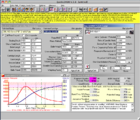I changed shot start pressure based on a previous comment which said to add 7200 psi for a jammed bullet and then subtract 146 psi for each .005" off the lands.
When using the shot start pressure default value of 3625 psi and adjusting Ba to 0.6615 to equal the actual MV of 2546, the calculated Pmax value is 58,368 or 94% of SAAMI max.
Does that appear reasonable to you? Thanks
Uncle-Buck: according to the QL manual, you add 7200 psi for a jammed bullet. That value has always seemed high to me, and put me in a position similar to yours in that QL was predicting pressure well over MAX, even though I wasn't getting any pressure signs or problems with brass life. For that reason, I have done some experimentation to estimate the increase in pressure due to a bullet seated into the lands. As far as I can tell, QL's use of the term "jammed" means a hard jam, possibly as far as .020" to .025" into the rifling. I can certainly understand why that might increase start pressure by 7200 psi. However, most of us that seat bullets into the rifling aren't using a "hard jam"; more likely somewhere in the neighborhood of .005" to .010" into the lands. In my hands, seating a bullet .005" to .010" into the lands is estimated to raise start pressure only by somewhere in the 800-1000 psi range. In other words, the increase in pressure as a bullet is seated farther and farther into the lands is not linear.
The bottom line is that anyone using QL can fiddle around, tweaking different aspects of the inputs to come up with adjustments so that the QL predictions match their observed velocity and drops. As someone new to using the program that is trying to set up user files for the first time, I would NOT recommend doing anything beyond what the user manual suggests until 1) you determine how well the QL outputs match your observed data and 2) you gain a little more familiarity using the program.
As far as comments from BCBRAD above - the effective working volume of a case is determined in QL from the dimensions in the selected bullet file, selected cartridge file and/or case length + actual case volume inputs. The program doesn't care how long the freebore of the rifle is, because it doesn't know. It only knows the seating depth and the overall effect on internal case volume based on the bullet selected. The change in pressure as bullets are seated farther and farther out in the case is determined primarily by three variables, friction, the change in effective case volume and resistance to movement as the bullet touches/enters the lands. The effects of these variables are not uniform as the bullet is seated deeper and deeper into the rifling until a "hard jam" is reached. As I suspected, the math given above for estimating pressure variance due to freebore length is simply some made up formula. It might appear to work, but it in no way reflects what is actually occurring when we actually pull the trigger, nor is it a good way to make estimates of pressure. As I stated previously, it is very likely that the increase in pressure as we seat bullets into the lands is not linear with respect to distance. Further, the length of freebore doesn't need to be divided by anything simply because once the bullet starts moving, the resistance to movement will essentially add very little pressure at all until the the rifling is reached (i.e. - once the bullet is moving, it doesn't really matter whether the freebore is .050" or .250", neither one is going to add much in the way of pressure to the total. In fact, With either freebore, the start pressure should remain at the default setting of 3626 psi, not have some fraction of the "jammed" start pressure added. The bullet isn't jammed, it's not even touching the rifling, why increase the pressure over the preset standard value at all? For bullets NOT seated into the lands, regardless of freebore length, there is simply no reason to do anything with the number for increased start pressure (7200 psi) with jammed bullets at all. All that ends up doing is markedly increasing the start pressure and the the peak pressure, making it appear as though a given load might be overpressure when, in fact, it is not.
Use the 3626 psi preset value until a bullet is seated into the lands, regardless of the length of the freebore or how far off the lands the bullet is seated. The program already calculates change in pressure due to any change in case volume due to a change in seating depth. At that point, you can decide how much to raise start pressure between zero and a "hard jam" (+7200 psi). As I stated before, it's unlikely to be linear, but that's something that needs to be determined by the end user with their specific setup.
It's a free country, anyone can do whatever they like with QL and adjust it in whatever fashion they see fit. However, new users of QL need to be very cautious when seeking advice on how to adjust the program. IMO - your best bet is to start with the manual, not someone's made-up formula from the internet. The start/initiation pressure represents a significant amount of the peak pressure and can therefore have a very dramatic effect on peak pressure when using QL. If a mistake is made, the effect can go either way; a load that is predicted to be way over MAX pressure, but actually isn't, OR a load that appears to be safe, but might actually be several thousand psi over MAX. Why risk that?











